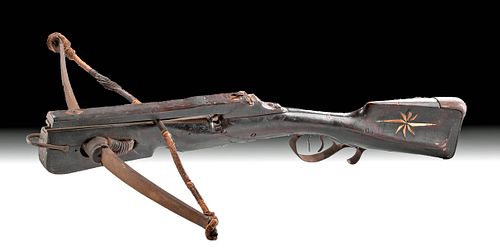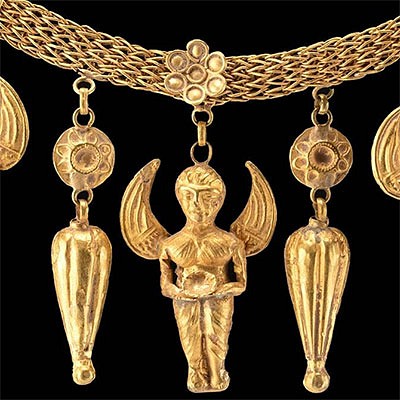18th C. Holy Roman Empire Handmade Crossbow
Lot 140b
About Seller
Artemis Gallery
686 S Taylor Ave, Ste 106
Louisville, CO 80027
United States
Selling antiquities, ancient and ethnographic art online since 1993, Artemis Gallery specializes in Classical Antiquities (Egyptian, Greek, Roman, Near Eastern), Asian, Pre-Columbian, African / Tribal / Oceanographic art. Our extensive inventory includes pottery, stone, metal, wood, glass and textil...Read more
Categories
Estimate:
$7,000 - $10,000
Absentee vs Live bid
Two ways to bid:
- Leave a max absentee bid and the platform will bid on your behalf up to your maximum bid during the live auction.
- Bid live during the auction and your bids will be submitted real-time to the auctioneer.
Bid Increments
| Price | Bid Increment |
|---|---|
| $0 | $25 |
| $300 | $50 |
| $1,000 | $100 |
| $2,000 | $250 |
| $5,000 | $500 |
| $10,000 | $1,000 |
| $20,000 | $2,500 |
| $50,000 | $5,000 |
| $100,000 | $10,000 |
| $200,000 | $20,000 |
About Auction
By Artemis Gallery
Dec 3, 2020
Set Reminder
2020-12-03 10:00:00
2020-12-03 10:00:00
America/New_York
Bidsquare
Bidsquare : Fine Antiquities, Ethnographic & Fine Art
https://www.bidsquare.com/auctions/artemis-gallery/fine-antiquities-ethnographic-fine-art-6119
Features classical antiquities, ancient and ethnographic art from cultures encompassing the globe. Egyptian, Greek, Roman, Etruscan, Near Eastern, Asian, Pre-Columbian, Native American, African / Tribal, Oceanic, Spanish Colonial, Russian, Fine Art, so much more! All legally acquired, legal to sell. Artemis Gallery info@artemisgallery.com
Features classical antiquities, ancient and ethnographic art from cultures encompassing the globe. Egyptian, Greek, Roman, Etruscan, Near Eastern, Asian, Pre-Columbian, Native American, African / Tribal, Oceanic, Spanish Colonial, Russian, Fine Art, so much more! All legally acquired, legal to sell. Artemis Gallery info@artemisgallery.com
- Lot Description
Europe, Holy Roman Empire (modern day Germany), ca. 1700 to 1740 CE. A beautiful handmade crossbow that would have been a prized possession. The bow itself is made from heavy steel, with a thick, twisted hemp string that has an antique repair on one side. There is a bone arrow rest on the top of the fruitwood tiller. The trigger is also iron. On the stock are small ebony wood and ivory inlays that form a starburst motif. During the Renaissance, crossbows like this one were covered in dense, ornate iconography often depicting religious or moralistic scenes; the sparing and elegant style of this example reflects the changing stylistic sensibilities brought on the by the Protestant Reformation. Size: 22.5" W x 29.5" H (57.2 cm x 74.9 cm)
During the medieval period, Europeans used crossbows as weapons of war; by the time this crossbow was made, however, they had become primarily hunting weapons and ways of preserving traditional culture. Shooting clubs, especially in great cities of the Holy Roman Empire such as Aachen, Nuremberg, Augsburg, and Cologne, arose in the early modern period, giving urban men an important social outlet. Members would represent these clubs during festivals and gatherings. A crossbow like this one would have belonged to one of these men, handmade to his specifications.
For more information on crossbows of this type, see the Deutches Historisches Museum (Berlin) exhibition, "Die Armbrust: Schrecken und Schonheit" (The Crossbow: Terror and Beauty), 9/20/2019 to 3/8/2020.
Provenance: private J.H. collection, Beaverton, Oregon, USA, acquired in February 2015; ex-Tortuga Trading, Inc., Encinitas, California, USA
All items legal to buy/sell under U.S. Statute covering cultural patrimony Code 2600, CHAPTER 14, and are guaranteed to be as described or your money back.
A Certificate of Authenticity will accompany all winning bids.
We ship worldwide and handle all shipping in-house for your convenience.
#151116String has an antique repair on one side. The wood of the stock and tiller are weathered, with some small fissures in various places, but nothing that is threatening the integrity of the bow. There is also a small chip from the wood just behind the arrow rest. The bone and ivory components have rich patina. Ivory is less than 5% of the total piece.Condition
- Shipping Info
-
All shipping is handled in-house for your convenience. Your invoice from Artemis Gallery will include shipping calculation instructions. If in doubt, please inquire BEFORE bidding for estimated shipping costs for individual items.
-
- Buyer's Premium



 EUR
EUR CAD
CAD AUD
AUD GBP
GBP MXN
MXN HKD
HKD CNY
CNY MYR
MYR SEK
SEK SGD
SGD CHF
CHF THB
THB

















